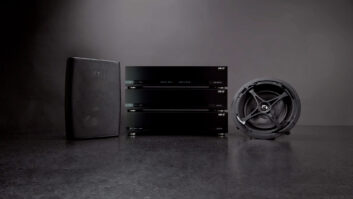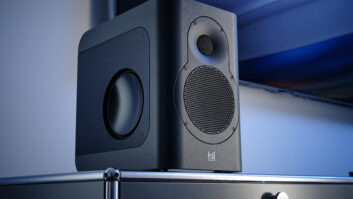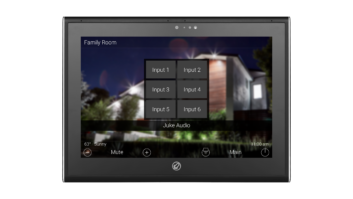
Peerless-AV’s PeerSound wireless transmitter with its receiver/ amplifier laying on top. It always tickles me to hear the way my integrator friends pronounce the word “Sonos.” There’s a resigned acceptance in the way they stress the first syllable, layered with a drooping air of weary contempt in the second. And I get that. There’s something kooky about the fact that a self-contained consumer music system that was never designed for custom integration has become the de facto distributed audio system of our industry. Sure, the margins on Sonos are awful. And yes, for a system with such supposedly simple setup, Sonos can be a networking nightmare. But really, until very recently, if you wanted to install an easily retrofitted, wireless multiroom music system, what were your alternatives? Thankfully, the custom industry is finally catching up to the concept of wireless distributed audio in a serious way, as evidenced by products like Peerless-AV’s PeerSound Wireless Audio System.
Perhaps it’s not really reasonable or fair to compare something like the PeerSound directly to Sonos. After all, the Peerless-AV system isn’t really a library management or content distribution system. It doesn’t access your iTunes files (at least not own its own); it doesn’t tap straight into streaming internet radio services; it lacks volume or gain control capabilities; there isn’t even an “App for That.”
But what the PeerSound lacks in bullet point features, it more than makes up for in installation flexibility. In essence, what Peerless-AV has created here is a rack-mountable, easily concealable wireless cable replacement system, capable of delivering eight channels of uncompressed, slightly-better-than- CD-quality up to 140 feet.
The PeerSound consists primarily of two components: the ADS100-B transmitter (that’s the rack-mountable part; the package comes with ears and screws) and the ADS100-A252 amplifier (which is a little smaller than a dual-gang wall box and is designed for discreet inwall installation). Installation of the former is incredibly straightforward, mostly because there’s no complicated wireless setup (the PeerSound establishes its own proprietary WiFi network), and no control connections to worry about (again, this system is merely intended to replace wires). One thing in particular that I love about the ADS100-B transmitter is that it’s capable of accepting either a line-level or speaker-level input for each of its eight channels, which really adds to its flexibility and expands the number of input devices that can be used with the system. You could, for example, use two of its channels to wirelessly drive the surround speakers in a home theater system that relies on an AV receiver without preamp outputs and use the rest for multiroom audio. Since the system isn’t rigidly locked down to one self-contained control ecosystem, the possibilities are really only limited by your imagination.
Given the simplicity of the system, setting up the ADS100-B transmitter consists of really nothing more than plugging in power, attaching your lineor speaker-level sources, and installing transmitter modules. That last step is one of the PeerSound’s only tricky bits, and it’s really the step during which I had to ditch the somewhat confusing instruction manual and go into trial-and-error mode before I really understood it.
Out of the box, the PeerSound comes with one transmitter module (ADS100-TX14) and one receiver module (ADS100-RXS). The “14” in “TX14” denotes that the transmitter only broadcasts the input from channels 1 through 4. If you want to un-tap the full eight-channel capabilities of the PeerSound, you’ll have to order the ADS100-TX58 (“58,” of course, standing for Channels 5 through 8). My review system didn’t come with the TX58, in effect leaving me with a two-source, four-channel wireless distribution system.
I specifically mentioned the “two-source” part because the choice between distributing two stereo pairs of audio or four mono audio streams from inputs one through four is determined not at the transmitting end, but rather at the receiving in. My review system (and from what I gather, the default system shipped to integrators, as well) came with one ADS100-RXS (stereo) receiver module, which plugs directly into the ADS100-A252 amp. When pairing the TX and RX modules, which is an incredibly simple, straightforward, intuitive process, the RXS module locks onto either channels one and two, or three and four; or, if you have the TX58 transmitter plugged into the second TX port on the ADS100-B, you also have the choice of accessing channels five and six, or seven and eight.
If you opt for the RSM (mono) receiver module, you instead select from the inputs individually, and both channels of the amp output the same mono signal. The manual notes, though, that you cannot bridge the channels for additional power output.
The only other tricky thing about the setup process (at least in my case) was delivering power to the ADS100-A252 amp. Since it’s designed for completely hidden in-wall or in-ceiling installation, there isn’t a plug for a wall wart. It’s designed to be fed directly with in-wall power. Since I wasn’t installing the system in-wall, I had to cook up my own power source using a mutilated power cord connected to some 12AWG Romex electrical cable. If I’m reading the manual correctly, Peerless also offers an on-wall accessory kit (ADS100-PW), which includes the cables required for power in on-wall installations.
I also unfortunately didn’t have any architectural speakers lying around with which to test the amp, but instead connected it to a pair of GoldenEar Technology’s Triton Seven tower speakers, honestly not expecting much in terms of sound quality but hoping nonetheless to at least test out the functionality of the system until I could borrow some in-walls. Much to my very pleasant surprise, though, the 2×25-watt amp delivered a shocking amount of kick via the tower speakers, with nice dynamic range, wonderful clarity, and no dropouts.
The latter is particular surprising, given that connected the ADS100-B transmitter to the zone two output of the Anthem D2v preamp in my main AV rack (a veritable Wi-Fi black hole), and the ADS100-A252 amp, although only about 25 feet from the source, was still four walls (two of them water pipe-filled bathroom walls) and a couple of closets away from being “line-of-sight.” What definitely helped was the included Remote Cable Kit, which allows you to move the antenna up to 10 feet away from the TX module to which it’s attached. Of course, if you opt for a second TX module to tap into channels five through eight of the ADS100-B, you’ll need an additional Remote Cable Kit.

The PeerSound transmitter, showing all eight inputs. It sounds complicated, to be sure, and during my initial setup, I might have thrown the instruction manual against the wall once or twice in frustration. But now that I’ve done it once, I feel like I could probably set up the PeerSound system from scratch in about five minutes (not counting the time it would take to saw into walls and make electrical connections).
If the system were destined to become a permanent fixture in my home, I’ve thought of all sorts of custom tweaks I could make. For one, I’d connect the ADS100-B transmitter to a switchable power outlet controlled by my Control4 system, since the only other way of turning it on and off is the power button on the front.
For all its frustrations, though, the Peerless-AV Wireless Audio System allowed me to do what few other multiroom audio systems can: design a truly custom wireless distributed music system using the source gear I want, the control system I want, and the speakers I want, with no extraneous components and no performance compromises.
800.865.2112
peerless-av.com
Kudos
The Peerless-AV PeerSound Wireless Audio System is a flexible, expandable, truly custom wireless audio distribution system that’s rock-solid, reliable, delivers excellent audio quality, and is easy to install once you get the hang of it.
Concerns
The instruction manual can be confusing, as can the fact that the system only gives you access to four of its eight channels without the addition of a second transmitter module, sold separately.
Product Specs
• Audio Input: 8 Line Level, 8 Speaker Level
• Wireless Frequency: 2.4 GHz Spread Spectrum
• Wireless Range: 140’ (43m)
• Streaming Latency: 42.7mS
• Audio Output: Speaker Level
• Power Supply: 5V, 2A
• Transmitter Dimensions: 17.32 x 1.84 x 6.90” (440 x 47 x 175mm)
• Transmitter Weight: 4.65 lbs (2.11kg)
• Receiver Dimensions: 4.13 x 5.19 x 1.49” (105 x 102 x 38mm)
• Receiver Weight: 3.79 lbs (0.63kg)
Micro Review: UT Wire’s Cord Organizers
by Jeremy J. Glowacki

My iPhone doesn’t hold its charge very well, so I like to leave it plugged in at my desk during the day. Trouble is, the cable isn’t that long and it often slides to the floor when I’m not using it and gets stepped on or run over by my chair. Enter UT Wire’s new Cable Stations, which are flexible rubber cord organizers, each with five channels for holding charger cables from on-the-go devices, such as phones, tablets, MP3 players, or laptops. The 2.75-inch Cable Station 2 and 1.5 inch Cable Station Mini (MSRP $5.99 each) are available in several colors to match furniture and décor. These simple devices helped clean up my desk and protect my charger cords. They won’t make your company any money, but they might save you from having to replace an Apple lightning cable after you stepped on it one too many times. For more information, visit www.ut-wire.com.







